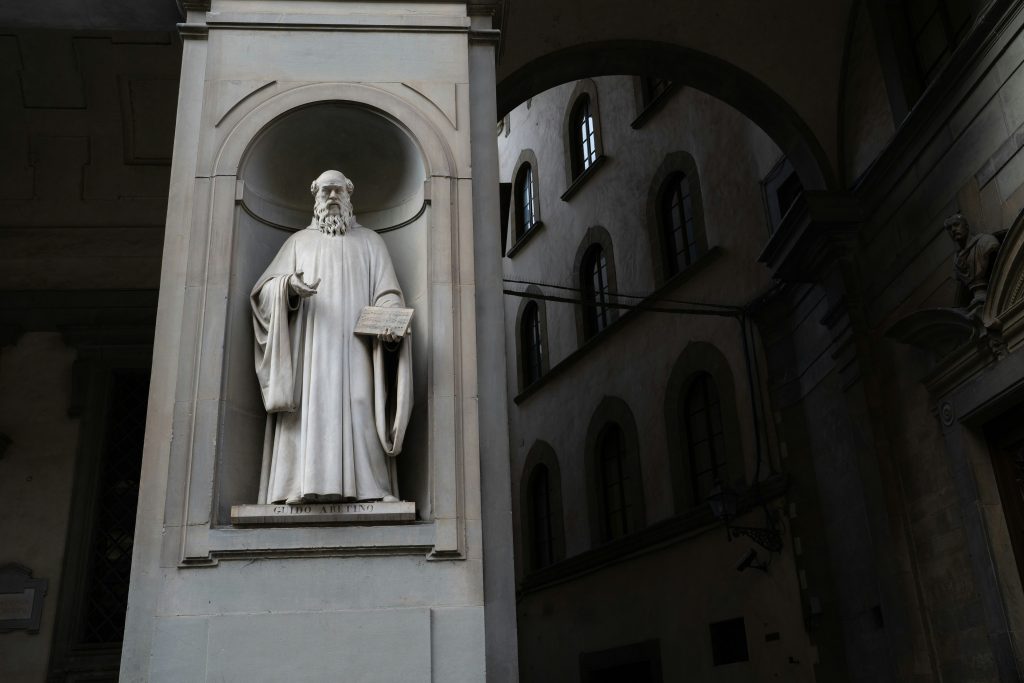The Origins of Guido of Arezzo
Guido of Arezzo, known here in town as “Guido Monaco” (Guido the Monk) , was a key figure in the history of Western music. Born between 991 and 992, he is remembered as one of the leading music theorists and monks of the Benedictine Camaldolese order.
His contribution is fundamental to the development of modern musical notation, and he is recognized as one of Arezzo’s most influential figures. Although time has erased some certainties about his life, his legacy continues to influence the world of music.
Guido’s origins are actually a matter of debate, with several cities, including Arezzo and Ferrara, claiming his birthplace. However, his strong connection to Arezzo, where he spent a significant part of his life and worked to revolutionize music theory, is undeniable. Arezzo has deeply rooted his legacy, celebrating him as one of its illustrious sons.
The Priestly and Musical Vocation of Guido of Arezzo
Guido of Arezzo began his religious journey as a Benedictine Camaldolese monk in 1013 at Pomposa Abbey, located near Ferrara. During his time at the abbey, Guido developed a growing interest in music and began teaching it to younger brethren. However, he realized the difficulties involved in learning Gregorian chants and musical rhythmics with traditional methods, which required numerous repetitions and the help of the teacher.
Guido decided to meet this challenge by devising a system that would allow anyone to read and interpret the intervals of tones and semitones without the help of the teacher.
During his time at Pomposa, Guido devised the “tetragrammaton,” a system of four lines on which to write musical notes, thus defining the basis of modern musical notation. This system was later evolved into the pentagram, which is still used today.
In addition, Guido developed the solmisation system, from which the modern names of musical notes are derived. His innovations revolutionized the learning and transmission of music, creating a legacy that would last for centuries.
The Birth of Modern Musical Notation
Guido of Arezzo is famous for creating the “tetragrammaton,” a system of musical notation consisting of four lines, which revolutionized the transmission of music. Before Guido’s invention, music was learned primarily by oral imitation, with neumes indicated on the syllables of the text.
The tetragrammaton allowed notes to be written more precisely by placing them on the lines or in the spaces between them. Guido proposed a unified system for representing notes, initially using a square as a symbol, which then evolved into a rhombus and finally an oval. This system laid the foundation for modern musical notation.
In addition to creating the tetragrammaton, Guido d’Arezzo is also responsible for introducing the musical note names we use today. He used the initial syllables of each hemistich of the first stanza of Paul Deacon’s hymn “Ut queant laxis” to identify the intervals of the musical hexachord: “Ut,” “Re,” “Mi,” “Fa,” “Sol,” and “La.”
This innovation represents the earliest form of solfege, called “solmisation.” Guido’s system did not aim to indicate the absolute pitch of sounds, but to correctly place the semitone between “E” and “F.” Later, the note “Ut” was replaced with “C” for matters of euphony, and “B” was added to complete the musical scale.
Guido in Arezzo
After a period of conflict with the conservative monks of Pomposa, Guido of Arezzo moved to Arezzo under the protection of Bishop Theodald. In this new phase of his life, Guido became a teacher of music and chant in the monastic school of the ancient cathedral on Pionta Hill.
Here, he devoted himself to innovating music teaching. To Bishop Theodald he dedicated his famous treatise “Micrologus,” a synthesis of his musical theories. The treatise, consisting of twenty short chapters, focused on the modalities of Gregorian chant and the composition of polyphonic music, becoming one of the most influential musical texts of the Middle Ages.
Guido’s arrival in Arezzo marked the beginning of a new era for music in the city. Thanks to his presence, Arezzo became a leading musical center. Guido placed himself at the head of the cathedral singing school, where he introduced modern musical notation and developed his system of solfege.
The city welcomed him warmly, recognizing the value of his work. Guido’s contribution to music made Arezzo famous as the “City of Music,” a title that is still a source of pride for its inhabitants today.
Guido of Arezzo and Aretine Musical Culture
Guido of Arezzo’s legacy helped define Arezzo as an important center of musical culture. The city is known as the “City of Music,” and this title is largely attributable to Guido’s innovations. In addition to the International Polyphonic Competition dedicated to him, the city is home to several prestigious musical institutions, including a renowned music high school.
A statue of Guido Monaco, located in a square dedicated to him, commemorates the importance of his contribution, celebrating Arezzo’s musical pride.
A Journey into the History of Music
To visit Arezzo is to immerse oneself in an extraordinary journey through the history of music. The city, thanks to figures like Guido of Arezzo, has left an indelible mark on the international music scene.
As you stroll through the streets of Arezzo, you can admire historical sites related to the Benedictine monk, such as the square named after him and the old Cathedral on Pionta Hill, where Guido taught. This experience allows one to appreciate the lasting impact Guido Monaco had on Western music.
The B&B Cento Passi Dal Duomo: An Aretine Hospitality Experience
The B&B Cento Passi Dal Duomo offers a welcoming base for exploring the wonders of Arezzo. Located in the heart of the city, the B&B allows visitors to fully immerse themselves in the historical and cultural atmosphere of the city, with the convenience of being within walking distance of the main sites related to Guido of Arezzo.
Staying here, one can enjoy an authentic experience of Arezzo hospitality while discovering the rich musical and cultural heritage of this fascinating Tuscan city.

